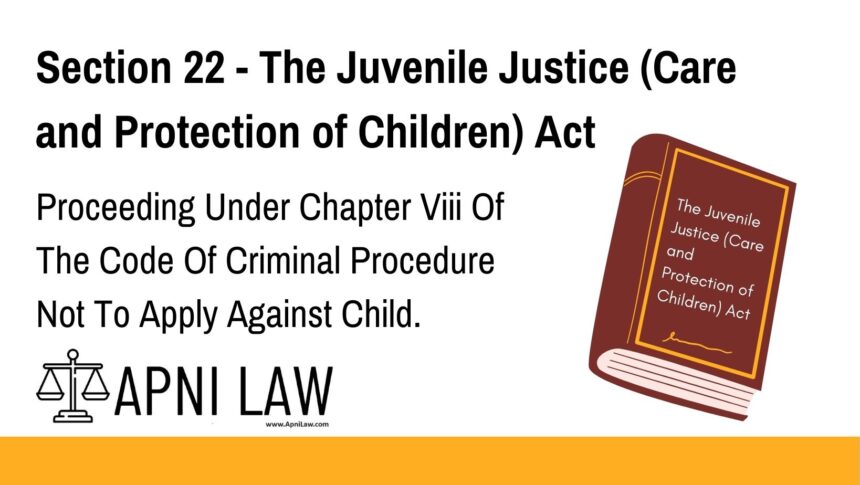Code: Section 22 JJ Act, 2015
“Notwithstanding anything to the contrary contained in the Code of Criminal Procedure, 1973, or any preventive detention law for the time being in force, no proceeding shall be instituted and no order shall be passed against any child under Chapter VIII of the said Code.”
Explanation of Section 22 JJ Act
Section 22 of the Juvenile Justice (Care and Protection of Children) Act, 2015, acts as a safeguard for children by ensuring that proceedings under Chapter VIII of the Code of Criminal Procedure, 1973 (CrPC)—which deals with “Security for Keeping the Peace and for Good Behaviour”—do not apply to them.
This provision overrides any contrary provision in CrPC or any other preventive detention law. It aims to protect children from coercive measures such as bond for good behavior or preventive detention, reinforcing the principle of child-friendly justice and restorative rehabilitation.
Key Points:
- Overrides CrPC Chapter VIII for children.
- Protects children from preventive legal actions like being bound over for keeping peace.
- Upholds the child-centric rehabilitative approach of the JJ Act.
Illustration
Example 1: Police Preventive Action
A 16-year-old boy is involved in a neighborhood scuffle. Ordinarily, under Chapter VIII of CrPC, police may initiate proceedings requiring a person to execute a bond for good behavior. However, due to Section 22 of the JJ Act, such proceedings cannot be initiated against a minor. Instead, the child must be handled through juvenile justice mechanisms like counseling or inquiry by the Juvenile Justice Board.
Example 2: Detention Avoided
Police receive information about a group of minors suspected to be planning a public disturbance. Instead of detaining them under preventive provisions of CrPC, authorities must refer the matter to the Juvenile Justice Board or Child Welfare Committee as appropriate.
Common Questions and Answers on Section 22 JJ Act
1. What is Chapter VIII of the CrPC?
Chapter VIII includes provisions related to preventive action, such as requiring individuals to maintain peace or good behavior through bonds or sureties. It is often used to prevent crimes before they occur.
2. Does Section 22 override all preventive detention laws?
Yes. Section 22 uses the non-obstante clause “notwithstanding anything…” to ensure that even if another law allows for preventive action, it does not apply to children.
3. What is the rationale behind this protection?
The JJ Act emphasizes rehabilitation and reintegration, not punishment. Preventive measures like those in Chapter VIII are considered inappropriate for children and counterproductive to their reform.
4. How are children handled instead?
Instead of preventive detention, children are dealt with by the Juvenile Justice Board through child-sensitive procedures such as supervision, counseling, and care plans.
5. Can a child ever be detained?
Yes, but only under specific circumstances outlined in the JJ Act and always with the aim of rehabilitation—not punishment or deterrence.
Conclusion
Section 22 of the Juvenile Justice Act ensures that children are not subjected to preventive measures under Chapter VIII of the CrPC. This reflects India’s commitment to child-centric justice, focusing on reformation and protection rather than punishment. Legal authorities must rely on the mechanisms of the JJ Act when dealing with children in conflict with law.
For detailed legal resources and expert help, visit ApniLaw 🚀








